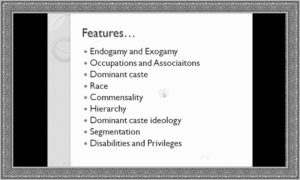Society’s classification has changed the course of society since ancient times. A caste system’s characteristics include a sense of superiority and inferiority among people of different classes. The caste system effect was so influential that its traces are still found at some corners, up to some extent. Many references emphasize the importance of being at the top of the hierarchy and having complete control over others.

FEATURES OF CASTE SYSTEM
- There was a segmental division of society in which they were classified in several units called as caste. The term caste used to present race or breed of a person. There have been 2800 different castes found in India and they have their own set of norms and beliefs.
- Hierarchy system was evolved in those times. There has been the degree of highness and lowness amongst people.
- Endogamy can be seen as a vital feature of the caste system. Endogamy is practicing marriage function in the same caste and it has been followed in India till now up to maximum extent. For example, even if anyone wishes to marry someone of other caste and class, he/she can face a powerful opposition and sometimes it can lead to Honor Killing. Honor killing is practicing death of people in love with different castes. In UP a couple was killed brutally just to satisfy caste ego which does not permit people to marry someone from other castes.
- Hereditary Status and Hereditary occupation are some of the basic features which can be called as an ascribed status of a person. It clearly means that caste is not something which is achieved by a man on the basis of merit. Indeed it is clearly a place which cannot be altered or switched. For example, a person born in Shudra category will do chores like cleaning toilets till his/her death. Likewise, a Brahmin’s son was bound to follow the priest culture; he was not allowed to go to his career choices.
- One of the most negative influences of the Caste system is also counted in its feature that is Food and Drinks indifference attitude by upper-class people. For example, if a Shudra prepared food and a Brahmin arrived at a temple where he is hungry. He will die of hunger but will not touch the food prepared by the lower class people. Such was the influence of caste practice in India. They were considered some garbage of society whose presence can be infectious to other people of society.
- Cultural Difference lingered in every caste and this cultural difference led to some of the major differences. For example in Brahmins, the people do not even touch meat or other non-veg materials but in other cases, people were interested in eating meats which acted as a barrier to cultural practice in different castes.
- Social segregation was also a deciding factor. It differentiated people on the basis of their economic status. For example, poor people were obliged to stay away from some of the richest people. For example, there was a different path for lower caste people; it was a general practice to not even have a tinge of a shadow of lower caste people.
- Ascribed status was one of the most fundamental characteristics of a caste system. The caste of a person was assigned to him and this will not change no matter he/she achieves any other things in life or not.
Also Read: How to End Caste System in India
I am Prerna Jha, pursuing mechanical engineering from KIIT, Odisha, But I Love to Read and Write Sociology Related Concepts and Theories. I have done schooling from MVM School, Bilaspur. I have interest in writing love stories or any specific genre. I pursue a great interest in quilting. Right now I am an aspiring writer who writes for various pages. I have participated in many social events. I am a social animal who likes to have maximum participation in any fest.
